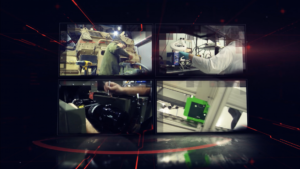Artificial Intelligence (AI) is revolutionizing video production, enhancing creativity, efficiency, and accessibility in ways previously unimaginable. From pre-production to post-production, AI tools streamline processes, enabling filmmakers to focus more on storytelling while technology handles the more mundane tasks.

In the pre-production phase, AI assists with scriptwriting and storyboarding. Advanced algorithms analyze successful screenplays, suggesting plot structures, character arcs, and dialogue that resonate with audiences. Tools like ScriptBook and Quillbot leverage AI to provide insights into the potential success of a script, helping writers refine their narratives before filming begins.
CASTING
Casting also benefits from AI applications. Tools like Cast It and Cinelytic analyze actor resumes, past performances, and audience reactions to recommend the best fit for roles. This data-driven approach enhances the casting process, ensuring filmmakers select actors who not only fit the character but also have the potential to draw in viewers.
PRODUCTION
During filming, AI technologies enhance production quality through camera automation and live monitoring. Smart cameras equipped with AI capabilities adjust settings in real-time, optimizing lighting, focus, and framing based on the scene’s requirements. This technology allows directors to capture stunning visuals without getting bogged down in technical details. Moreover, AI-powered drones provide breathtaking aerial shots, capturing angles that were once difficult or dangerous for human operators.
POST-PRODUCTION
Post-production is where AI truly shines, transforming the way editors approach their craft. AI-driven editing software like Adobe Premiere Pro and DaVinci Resolve uses machine learning algorithms to analyze footage, identifying the best takes and suggesting edits. These tools can recognize patterns, emotional cues, and key moments, significantly reducing the time editors spend sifting through hours of footage.
VISUAL EFFECTS
Moreover, AI plays a crucial role in visual effects (VFX) and animation. Technologies like deep learning and neural networks enable artists to create more realistic effects and animations efficiently. AI-driven tools can automate rotoscoping, a labor-intensive task, allowing artists to focus on more creative aspects of their work. This not only accelerates production timelines but also enhances the overall quality of visual storytelling.
SOUND DESIGN
Sound design and music composition also see the influence of AI. Tools like AIVA and Amper Music generate original scores based on the mood, genre, and style of the film. These platforms empower filmmakers with high-quality music that complements their visuals without the need for extensive licensing negotiations. Additionally, AI algorithms help in sound editing, ensuring that dialogue is clear and background noise is minimized, further enhancing the audience’s experience.
DISTRIBUTION
Finally, AI aids in distribution and marketing. Machine learning algorithms analyze audience preferences and viewing habits, allowing filmmakers to tailor their marketing strategies effectively. Platforms like Google Ads and Facebook Ads utilize AI to optimize ad placements, ensuring that trailers and promotional materials reach the right audience at the right time.
CONCLUSION
In conclusion, AI is a powerful ally in video production, streamlining processes, enhancing creativity, and improving overall quality. As technology continues to evolve, filmmakers can expect even more innovative tools that will help them tell compelling stories, making the art of filmmaking more accessible and efficient. Embracing AI not only transforms the production landscape but also opens new avenues for creativity and expression in the world of cinema.
10 Interesting Ways to Tell Your Story with Video- Sprocket Media Works
